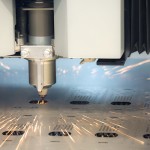The History of Laser Cutting
Each time that mankind has harnessed a new form of energy, it has resulted in a massive shift in the quality of life for all. Over the course of human history, the ability to master mechanical, chemical, electrical, and nuclear energy have all had tremendous impacts on the advancement of technology. In the introduction to his textbook Laser Materials Processing, Professor William Steen argues that we have now entered into a new industrial revolution, thanks to the development of coherent optical energy and the invention of the laser. He writes:
“Due to the discovery of the laser in 1960, optical energy in large quantities and in a controlled form is now available as a new form of energy for the civilized world.”
Although laser cutting is commonly called “new”, the technology can be traced all the way back to 1917. Albert Einstein first theorized the idea of laser technology in his paper on the quantum theory of radiation. Einstein postulated that stimulated photons prefer to travel together in the same state, with each photon amplifying the original input of radiation energy.
It wasn’t until the 1960s that the laser finally came to fruition. This groundbreaking technology was not create by one single person in isolation, but rather was the result of many brilliants minds sharing great ideas.
The first carbon dioxide laser was created in 1963 by Kumar Patel in New Jersey. Just a year later, engineers at Western Electric Engineering Research Center created a laser for drilling holes in diamond dies, which were to be used for manufacturing fine wires for electrical connections.
The first gas-assisted laser cutting experiments took place in 1967 by Peter Houldcroft, the Deputy Scientific Director at the Welding Institute in Cambridge. Cuts were made in stainless steel up to 2.5mm thick and at speeds up to 1m/min. The results of the experiment were published in the British Welding Journal. In this paper, Houldcroft writes:
“With the development of higher power lasers it should be possible to cut thicker and different materials including non metals. …The narrowness of the cut promises a precision not previously obtained with thermal cutting techniques.”

Fifty years later, high-powered lasers are now being used to cut a vast range of materials with highly accurate cuts, smooth finish, and microscopic tolerances. Used across many different industries, this technology is efficient and saves companies vast amounts of resources. Laser cutting also allows for manufacturing complex shapes & geometries without the need for tooling. Thanks to laser cutting, manufacturing will never be the same.
